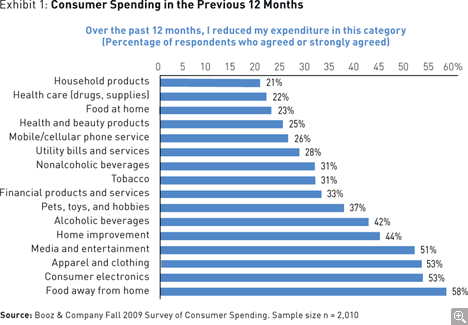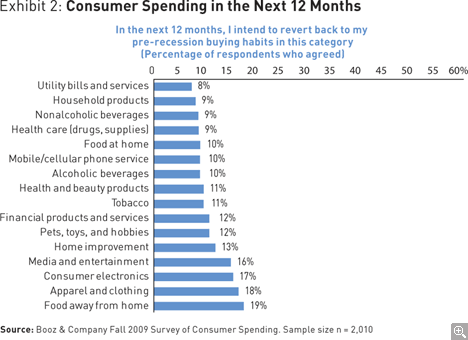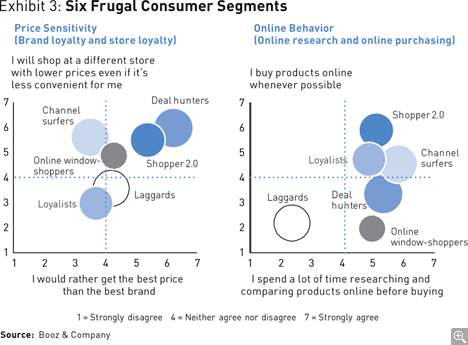The New Consumer Frugality
Retailers must adapt to the enduring shift in U.S. consumer spending and behavior, according to a new Booz & Company survey of buying habits.
A new survey of 2,000 U.S. consumers, the second issued by Booz & Company since the early days of the recession in October 2008, confirms that a “new frugality,” born of the Great Recession and evidenced by two consecutive years of declining per capita consumption, is now becoming entrenched among U.S. consumers and is reshaping their consumption patterns in ways that will persist even as the economy starts to recover.
A new frugality, characterized by a strong value consciousness that dictates trade-offs in price, brand, and convenience, has become the dominant mind-set among consumers in the United States — and probably in other wealthy countries as well. Two-thirds of American shoppers are cutting coupons more frequently, buying low price over convenience, and emphasizing saving over spending. Per capita consumption expenditure has declined across demographic groups. Consumer sentiment remains weak. These trends are not going to change, no matter the pace of economic change.
Annual consumer surveys conducted by Booz & Company during the past two years suggest that the deep and prolonged nature of the recession, in conjunction with longer-term trends — such as ongoing shifts in the share captured by retailers’ private labels and the greater online research shoppers do before going to the store — has hardened changes in consumer spending and behavior. Even as a slow recovery is under way, it is becoming clear that consumers are not going to step up to store counters with pre-recession alacrity. Marketers and retailers that wait for them to do so are taking a major risk with the futures of their companies. And as consumer demand returns, it will likely center on a different mix of price points, brands and private labels, and retail formats than prior to the recession.
In short, the Great Recession has forced consumers to shift their behaviors, and many of these new behaviors will stay in place. As consumers persist in more frugal behaviors — such as trading down to private labels and buying packaged foods rather than eating out — companies that rely on pre-recession strategies and tactics will find themselves struggling against strong headwinds.
Given the fundamental shifts in consumer behavior, consumer marketers and retailers — across categories as varied as food and beverage, home improvement, consumer electronics, and apparel — should be changing their product assortments, pricing strategies, advertising, and promotions. Companies that do this well will find the winds far more favorable, and they will prosper first and most in the new value-driven marketing environment.
Recessionary Behaviors Are Hardening
In the face of a recession that has caused two consecutive years of per capita consumption declines in the U.S. (for the first time since the Great Depression), an unemployment rate near 10 percent, and persistent concerns about the future, the frugal consumer behaviors that were first identified in the Booz & Company Fall 2008 Survey of Consumer Spending remain commonplace. Indeed, Booz & Company’s second annual consumer survey — conducted in the fall of 2009 and including a representative sample of about 2,000 U.S. consumers across demographics, geographies, product categories, and retail formats — revealed that frugal behaviors, such as reducing or deferring consumption, trading down to lower price points, purchasing “private label” brands (typically the house brands of retail stores), and shopping at discount outlets, are hardening into habits.
Most of the consumers surveyed said they continue to consider saving more important than spending (65 percent). They sacrifice convenience for price (65 percent), frequently use coupons (65 percent), and, to a lesser extent, prefer the best price to the best brand (55 percent). Further, over the past 12 months, consumers have continued to cut back on spending in 16 major categories, especially discretionary categories such as entertainment, apparel, electronics, and eating out — although on occasion they do spend on small indulgences for themselves, in categories such as health and beauty. (See Exhibit 1.)
More significantly, a year after the meltdown in the financial markets, less than 20 percent of consumers say they intend to revert to their pre-recession spending habits within the next 12 months. (See Exhibit 2.)
The newfound frugality and value consciousness informing consumer behaviors are not relegated to “opening price point” (OPP) merchandise (the lower-priced goods that typically include but are not limited to retailers’ private labels). Consumers are still buying across a wide range of price points, but they need more reason to justify trading up, whether they are moving from an OPP to midline price point or from midline to premium. They won’t accept a price gap unless they perceive a clear value advantage in quality or connect emotionally to key brand attributes. And even then, many consumers will still require a price break (via promotions and coupons) to rationalize trading up to the brands they prefer. They may also be unwilling to trade up if they perceive the jump as too great. For instance, some shoppers may trade up from a private label to a value-priced brand but still not buy a premium-priced brand.
It is also important to recognize that the new frugality is encouraged and supported by longer-term trends, such as the retail emphasis on private labels, the ease of shopper research and buying via digital media, and innovation and intensifying price competition among and within retail formats. For example, the increased use of consumer and trade promotions by manufacturers, the number of consumers who like the experience of “trading down,” and the ease of using online research to compare products and features as well as to identify which stores offer the best deals (not a factor in previous recessions) have all amplified price sensitivity. New retail formats, such as low-cost kiosks for DVD rentals, are also offering consumers more options as they seek out trade-down opportunities. These longer-term trends — in combination with the short-term pressure on shoppers’ checkbooks and their financial fears — have accelerated and reinforced the growing consumer emphasis on value: the best combination of price, brand, and convenience.
Finally, the behavioral differences inherent in the new frugality are hardening across demographics, including income, gender, ethnicity, and age. For example, although consumer spending in discretionary categories is slightly more constrained in some segments, such as women, lower income brackets, middle-aged consumers, and Hispanics and Asian Americans, there is surprisingly little difference in the expenditure reductions among demographic segments.
Beyond Traditional Demographics
To be sure, there are some significant differences among consumers when it comes to the new frugality. Although all consumers are more frugal and value-driven today, there is a significant degree of variation in their definitions of “value.” These variations reflect different approaches to spending categories, price sensitivity, brand loyalty, methods for researching products, and shopping preferences. The old consumer segments, based on demographic factors such as age and ethnic background, no longer seem as apt in distinguishing consumer behavior.
In an analysis of the shifts in consumer behavior and spending uncovered by the survey, six statistically significant consumer segments emerged. They represent relatively nuanced views of the population, essential for companies that seek to market to frugal, value-driven consumers:
- Shoppers 2.0: Representing the most technologically advanced 16 percent of the survey sample, the Shopper 2.0 segment shows the greatest tendency to buy online across categories. Its members are price sensitive, frequently use coupons, and exhibit little brand or format loyalty.
- Deal Hunters: Representing 21 percent of the survey sample, the Deal Hunters segment is highly price sensitive. Its members are heavy coupon users with low levels of brand or format loyalty. Unlike those in the Shopper 2.0 segment, they are not inclined to buy products online; they direct their price-focused online research to getting the best deal in the store.
- Online Window-shoppers: Representing 11 percent of the survey sample, this segment conducts a high level of research online but, like the Deal Hunters segment, is less likely to purchase online. Its members exhibit a more modest degree of price sensitivity and brand switching than those in the Shopper 2.0 and Deal Hunters segments.
- Channel Surfers: Representing 20 percent of the survey sample, people in the Channel Surfers segment are the most willing to hunt for the brands they love and most likely to switch retail destinations to seek out those brands at favorable prices. Members of this segment are the most likely to trade off convenience to get good deals on the brands they want.
- Loyalists: Representing 15 percent of the survey sample, the Loyalists segment is the least likely to change brands and retail formats, at least for reasons of price. Its members conduct research and buy online, often seeking to preserve their established brand preferences.
- Laggards: Representing 17 percent of the survey sample, the Laggards segment is the least interested in changing behavior. These individuals conduct very little online research or purchasing, and they exhibit the lowest level of coupon usage. They are not particularly motivated to switch brands or retail format. Their small number — less than one in five of the overall population — is itself a significant indicator of the magnitude of the overall shift in consumer behavior.
As the descriptions above indicate, behavioral traits, especially price sensitivity and online behavior, vary among these six segments. (See Exhibit 3.) Thus, marketers and retailers that use traditional approaches to targeting shoppers based on demographics alone risk missing opportunities to better meet shoppers’ needs and communicate with them more effectively. Conversely, by building behavioral insights — such as price sensitivity and online behavior, as well as category, retailer, and occasion preferences — into their marketing strategies to better target shoppers, marketers and retailers can create a new source of sustainable competitive advantage.
Two Marketing Imperatives for a Value-driven Era
To effectively compete as a consumer marketer or retailer and win over today’s consumers, you will need to reassess your marketing strategies and ensure that they are properly aligned with your operating models. You should undertake this work with two imperatives in mind.
First, you need an explicit and intense focus on value to address the new frugality among consumers. Whether you are a retailer or a marketer, this means examining and, as necessary, adjusting your product assortment and pricing strategies. In rethinking your assortment, assess your existing product portfolios by category. Review the number of price points and optimize the gaps between your price points in each category. Also review your innovation pipelines to ensure that the new products you launch all deliver clear value (with the right combination of brand and convenience) to attractive and growing customer segments.
In terms of pricing, resist the temptation to respond to competitive thrusts and consumer demands with blunt, across-the-board price reductions. Instead, identify the consumers that you have the “right to keep” on a profitable basis. In addition, it is essential to establish clear, dedicated pricing strategies, value propositions, and operating models for various channels in order to deliver the proper value in each channel and avoid incurring unnecessary complexity and costs.
The second imperative has to do with advertising and promotion. Your marketing goal, in this environment of new frugality, should be to create a path to purchase that addresses the decisions consumers are more likely to make in this context: where to shop, which price points to consider (such as midline or premium), and brand selection outside the store or at the shelf. To accomplish this, you will need to embrace new advertising and promotion capabilities, particularly innovative digital approaches that better engage consumers and activate desired behaviors. You will find that more effective advertising and promotion approaches, based on enhanced consumer insights and more integration of your activities all along the path to purchase, go hand in hand with a greater focus on value.
In your advertising and promotions, capture deeper insights into consumer behavior by brand, shopping occasion, and particularly retail format. This is a key first step to building stronger shopper marketing capabilities. Shopper marketing, which currently accounts for approximately US$35 billion in spending for consumer packaged goods marketers in the United States and is the fastest-growing category in advertising and promotion, offers the means to better understand the way shoppers make decisions, to identify the key equity messages required to best communicate with them and drive desired behaviors at each stage of the path to purchase, and to deliver differentiated messages accordingly. Finally, you should align metrics across in-store and out-of-store marketing, moving beyond demographics for advertising and beyond sales lift for promotions.
In terms of the overall marketing effort, the most effective companies are also strengthening their “clicks to bricks” integration. You should consider focusing your digital marketing and e-commerce efforts based on a robust understanding of the consumer segments that are most critical to your current profitability and future growth. Because 30 to 60 percent of retail sales across a variety of major categories are now influenced by online research and shopping, you should also devote explicit attention to engaging shoppers along the full path to purchase, rather than treating online and in-store interactions as silos.
Conclusion
If consumer spending is destined to remain soft during a prolonged recovery and consumer behavior has changed in enduring ways, waiting out a return to the pre-recession, premium-driven consumer mind-set is not a viable strategy. Instead, marketers and retailers need to adapt to the new realities of frugal behavior and spending.
The result will be a step change in your overall marketing capabilities. You will learn to better influence shoppers all along the path to purchase — from home to store and in between. You will build your capacity for shopper marketing, capturing insights about consumers that you have never had before. You will align your marketing efforts shelf-back with brand advertising and promotional marketing, and you will address the right levers across the value equation — price, volume drivers, cost-efficiency — to enhance shareholder value. Those companies that can achieve this will be the winners in an era of new consumer frugality.![]()
Author PROFILES:
- Matthew Egol is a partner in Booz & Company’s global consumer and media practice and is based in New York. He focuses on growth strategy and sales and marketing effectiveness for clients in the consumer products and media industries.
- Andrew Clyde is a Booz & Company partner based in Dallas. He is the managing partner of the Dallas office and is the practice leader for the North American energy, chemicals, and utilities practice. He serves clients across these value chains, focusing on customer- and market-back strategy and operating model design.
- Kasturi Rangan is a principal with Booz & Company in Cleveland. He focuses on corporate and business unit growth strategies for automotive and other industrial companies.




